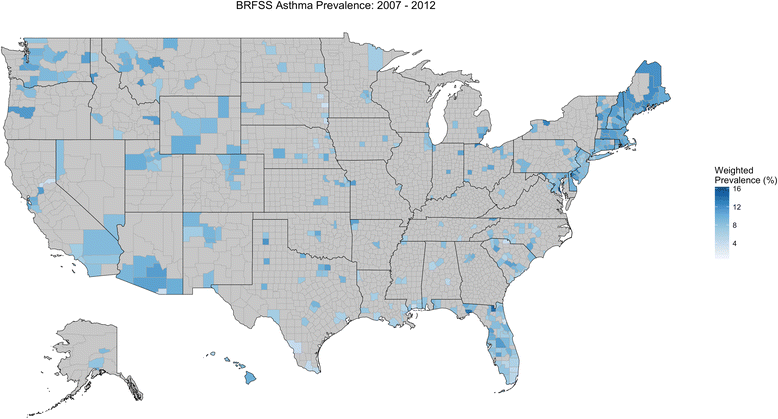Gender-specific determinants of asthma among U.S. adults
- PMID: 28138394
- PMCID: PMC5259982
- DOI: 10.1186/s40733-017-0030-5
Gender-specific determinants of asthma among U.S. adults
Abstract
Background: Asthma, a chronic respiratory disease affecting over 18.7 million American adults, has marked disparities by gender, race/ethnicity and socioeconomic status. Our goal was to identify gender-specific demographic and socioeconomic determinants of asthma prevalence among U.S. adults using data from the Behavioral Risk Factors Surveillance System (BRFSS) and the National Health and Nutrition Examination Survey (NHANES).
Methods: Gender-specific regression analyses were performed to model the relationship between asthma prevalence with age, race/ethnicity, income, education level, smoking status, and body mass index (BMI), while taking into account the study designs.
Results: Based on BRFSS data from 1,003,894 respondents, weighted asthma prevalence was 6.2% in males and 10.6% in females. Asthma prevalence among grade 2 obese and grade 3 obese vs. not overweight or obese women was 2.5 and 3.5 times higher, respectively, while that in men was 1.7 and 2.4 times higher; asthma prevalence among current vs. never smoker women was 1.4 times higher, while that in men was 1.1 times higher. Similar results were obtained with NHANES data from 13,364 respondents: asthma prevalence among grade 2 obese and grade 3 obese vs. not overweight or obese respondents was 2.0 and 3.3 times higher for women, though there was no significant difference for men; asthma prevalence among current vs. never smokers was 1.8 times higher for women and not significantly different in men. Asthma prevalence by race/ethnicity and income levels did not differ considerably between men and women.
Conclusions: Our results underscore the importance of obesity and smoking as modifiable asthma risk factors that most strongly affect women.
Keywords: Adult asthma; Asthma; Obesity; Smoking.
Figures

Similar articles
-
Prevalence of asthma among adult females and males in the United States: results from the National Health and Nutrition Examination Survey (NHANES), 2001-2004.J Asthma. 2009 Oct;46(8):759-66. doi: 10.1080/02770900903067895. J Asthma. 2009. PMID: 19863277 Free PMC article.
-
Core state preconception health indicators - pregnancy risk assessment monitoring system and behavioral risk factor surveillance system, 2009.MMWR Surveill Summ. 2014 Apr 25;63(3):1-62. MMWR Surveill Summ. 2014. PMID: 24759729
-
Prevalence of selected risk behaviors and chronic diseases and conditions-steps communities, United States, 2006-2007.MMWR Surveill Summ. 2010 Sep 24;59(8):1-37. MMWR Surveill Summ. 2010. PMID: 20864923
-
Prevalence of selected risk behaviors and chronic diseases--Behavioral Risk Factor Surveillance System (BRFSS), 39 steps communities, United States, 2005.MMWR Surveill Summ. 2008 Oct 31;57(11):1-20. MMWR Surveill Summ. 2008. PMID: 18971922
-
Behavioral and Pharmacotherapy Weight Loss Interventions to Prevent Obesity-Related Morbidity and Mortality in Adults: An Updated Systematic Review for the U.S. Preventive Services Task Force [Internet].Rockville (MD): Agency for Healthcare Research and Quality (US); 2018 Sep. Report No.: 18-05239-EF-1. Rockville (MD): Agency for Healthcare Research and Quality (US); 2018 Sep. Report No.: 18-05239-EF-1. PMID: 30354042 Free Books & Documents. Review.
Cited by
-
Impact of Individual versus Geographic-Area Measures of Socioeconomic Status on Health Associations Observed in the Behavioral Risk Factor Surveillance System.AMIA Annu Symp Proc. 2021 Jan 25;2020:707-716. eCollection 2020. AMIA Annu Symp Proc. 2021. PMID: 33936445 Free PMC article.
-
Factors associated with exacerbations among adults with asthma according to electronic health record data.Asthma Res Pract. 2019 Jan 18;5:1. doi: 10.1186/s40733-019-0048-y. eCollection 2019. Asthma Res Pract. 2019. PMID: 30680222 Free PMC article.
-
Role of Differential Estrogen Receptor Activation in Airway Hyperreactivity and Remodeling in a Murine Model of Asthma.Am J Respir Cell Mol Biol. 2019 Oct;61(4):469-480. doi: 10.1165/rcmb.2018-0321OC. Am J Respir Cell Mol Biol. 2019. PMID: 30958966 Free PMC article.
-
A cross-sectional analysis of associations between environmental indices and asthma in U.S. counties from 2003 to 2012.J Expo Sci Environ Epidemiol. 2022 Mar;32(2):320-332. doi: 10.1038/s41370-021-00326-4. Epub 2021 Apr 24. J Expo Sci Environ Epidemiol. 2022. PMID: 33895778 Free PMC article.
-
Polysomnographic variables in Alternate overlap syndrome: data from sleep heart health study.J Community Hosp Intern Med Perspect. 2019 Apr 12;9(2):108-112. doi: 10.1080/20009666.2019.1595951. eCollection 2019 Apr. J Community Hosp Intern Med Perspect. 2019. PMID: 31044041 Free PMC article.
References
-
- Akinbami L, Moorman J, Bailey C, Zahran H, King M, Johnson C, Liu X. NCHS data brief, no 94. Hyattsville: National Center for Health Statistics; 2012. Trends in asthma prevalence, health care use, and mortality in the United States, 2001–2010. - PubMed
-
- Schiller JS, Lucas JW, Ward BW, Peregoy JA. Summary health statistics for U.S. adults: National Health Interview Survey, 2010. Vital and health statistics Series 10, Data from the National Health Survey. 2012;252:1–207. - PubMed
-
- Britton J, Pavord I, Richards K, Knox A, Wisniewski A, Wahedna I, Kinnear W, Tattersfield A, Weiss S. Factors influencing the occurrence of airway hyperreactivity in the general population: the importance of atopy and airway calibre. Eur Respir J. 1994;7:881–887. - PubMed
Grants and funding
LinkOut - more resources
Full Text Sources
Other Literature Sources

